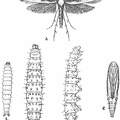The simple nests and tubes that have been described are made by spiders, most of which spin no other webs. The larger and better known cobwebs for catching insects are made by comparatively few species. On damp mornings in summer the grass-fields are seen to be half covered with flat webs, from an inch or two to a foot in diameter, which are considered by the weatherwise as signs of a fair day. These webs remain on the grass all the time, but only become visible from a distance when the dew settles on them. Figure is a diagram of one of these nests, supposed, for convenience, to be spun between pegs instead of grass. The flat part consists of strong threads from peg to peg, crossed by finer ones, which the spider spins with the long hind-spinnerets
- Author
- The Structure and Habits of Spiders
Author: James Henry Emerton
Published in 1883
Available from gutenberg.or - Posted on
- Saturday 27 May 2023
- Dimensions
- 900*446
- Tags
- Insects
- Albums
- Visits
- 390
- Downloads
- 30
 Download Photo
Download Photo





